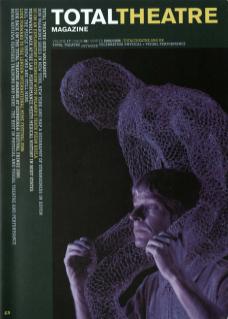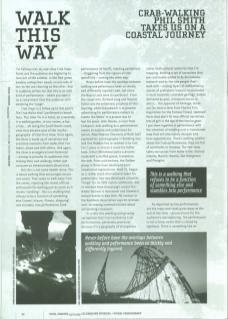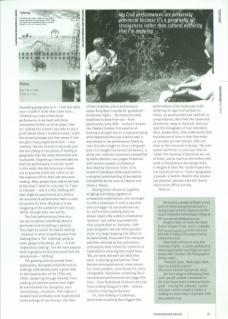I'm halfway into my new show Crab Steps Aside and the audience are beginning to look out of the window: to the flat-green bowlers rolling their woods on one side of me, to the sea churning on the other. And it suddenly strikes me that this is an odd kind of performance – where you take it as a compliment that the audience isn't watching the 'stage'.
Crab Steps is a follow up to last year's The Crab Walks that I performed in beach huts. This time I'm in a hotel, on a veranda, in a walled garden, in tea-rooms, a bar, a lido... all along the South Devon coast, sites that became part of the 'mythogeography' of that first show. Once again, the show is made up of narratives and snatched moments from walks that I've taken, alone and with others. And again, the show is evangelical and rhetorical, aiming to provoke its audiences into making their own walkings rather just consume an entertainment about mine.
But this is not some health-drive. This is about walking that encourages excess and waste. That seeks to walk away from the norms, rejecting the recent official enthusiasm for walking just as much as it resists 'rambling'. This is a walking that refuses to be a function of something else (travel, leisure, fitness, shopping) and stumbles into performance (and performance of itself), meeting performers – staggering from the rigours of site-specificity – coming the other way.
Never before have the overlaps between walking and performance been so thickly and differently layered (well, not since the Nazca Lines were in operation). From the visual arts, Richard Long and Hamish Fulton are the wilderness prophets of this layering, while Groundwork is at present advertising for performance makers to create 'Art Walks’ in a project due to last for years. John Davies, a vicar from Liverpool, uses walking as a performative means to explore and understand his parish. Mike Pearson (formerly of Brith Gof) explored his autobiography in Bubbling Tom and Dee Heddon has re-walked it for him. Carl Lavery re-traces a route his father took. Simon Whitehead walks a drovers' route with a stuffed goose, tracked on the web. From architecture, the Stalker group in Rome have developed post-situationist explorations. Walk 21, begun as a rather staid international event for pedestrians, has now developed a healthy 'fringe' for its 2005 Zurich conference. Not to mention Kate Armstrong's recent PreAmble festival in Vancouver and Glowlab's annual events in New York. My contact in the Ramblers Association says he receives ever-increasing communications about art/walking crossovers.
It is into this seething and growing variegation that I've inserted my Crab performances, perversely provincial because it's a geography of strangeness rather than cultural authority that I'm mapping. Walking a set of narratives that are continually added to by discoveries, research and by the new people that I walk with – adding layers of mathematics, stories of prehistoric humans incarcerated in local hospitals, unstable geology, bodies delivered by post, miniature navies in attics... the opposite of heritage, these are (to steal a term from Charles Fort, inspiration for the Fortean Times) 'damned’ facts that don't fit into official narratives, bits of grit in the eye of the tourist gaze. I put them together in performance with the intention of handing over a translucent map that will alternately sharpen and haze expectations. There's nothing localist about the Crab performances; they are full of wormholes to faraway. The new show takes narratives from walks in the Channel Islands, Munich, Narnia, San Gimignano and Prangins.
As important as the performances are the maps and cards given away at the end of the sho – provocations for the audience's own exploring. The performance is not a linear event that is closed by applause. There is something like an expanding geography to it – I felt this when once I couldn't think what came next... I flashed up a map of the whole performance in my head and chose somewhere further on to set down, then as I related this strand I was able to see a point ahead where I could turn back, insert the missed passage and then weave it into the part I had jumped back from – I was 'walking' the two strands in my head, just like the sliding of two planes of feeling or geography that the walks themselves aim to provoke. Forgetting a line reminded me that the performance is not the point in this work; that the structure is there not to promote itself, but rather to set the audience off on their own structure-making. Many people have said at the end of the show ‘I went on a journey' or 'I was in a dream' – and it is this 'drifting off’ that might be experienced as a failure for one kind of performance that is a test of success for mine. Because it is the imagining of the audience's own future ‘drifts' through their own worlds.
The Crab performances have also set out to express something about a particular kind of walking in general. This might be called ‘disrupted walking’ – because it relies on getting away from walking that is 'for’ anything: going to work, going to the shops, etc. – or even 'exploratory walking’, but the most popular term is going to be that borrowed from the situationists – ‘drifting'.
The growing activity around these exploratory, disrupted and performative walkings undoubtedly owes a great deal to the situationists of the 1950s and 1960s, wandering through (mainly) Paris seeking out ambient places that might be transformed into disruptive, even revolutionary, situations. Their legacy is evident (and profitably to be experienced) in the writings of Iain Sinclair, the films of Patrick Keiller and in performance-maker Anna Best's wonderful guidebook Occasional Sights... But there are other traditions to draw from too – from adventurous early 20th Century trampers like Stephen Graham (his practice of drawing a straight line on a map and seeing what happened when you tried to walk it was echoed in the performance Totem by Lone Twin who sought to carry a telegraph pole in a straight line across Colchester), a whole neo-romantic movement exemplified by Arthur Machen, neo-pagan flirtations with ancient nomadic architecture described by Francesco Careri in his essential handbook Walkscapes and an ecological understanding of perception exemplified by the work of Eleanor and James J. Gibson.
Putting these influences together, mingling and sliding together in unexpected combinations, one can begin to walk a landscape in such a way that one can trigger its own performances. So, performative walking does not always require the walker to themselves ‘perform', but rather to provoke the sites around them to. Recently, I left some enigmatic red and white painted sticks in a large shopping site about to be demolished, these were first removed and then returned by the contractors, confused by what historical, technical or superstitious meaning they might have... 'Yes, we never did work out what they were,' a security guard told me. Sites become more geometrical, more rumourful, more unstable, more dreadful, more changeable. Sometimes something like a conventional performance can trigger the sites – Drew Mulholland of Vernon Arts Lab fame walking Glasgow in 18th Century costume conjuring de Quincey.
So, crab walking is a sideways, performative walking that triggers the performative in the landscape itself, rendering its signs and symbols as actors, as questionable and codified, as conspiratorial, that finds the connected and the far away in the local, that can read the hieroglyphs of now redundant mass-productions, that understands that the pleasure of ruins is that they make us consider our own futures, that can draw on the resources of drama. The crab walker/performer is conscious that we 'make’ the meaning of spaces by our use of them, just as much as the workers who build or the planners who design them. In Wrights & Sites' Mis-Guide Project this has become known as 'mytho-geography' a pseudo-scientific theatre that anyone can practice, perhaps even the Tourist Information Office one day.
Walk on...
Phil Smith is a member of Wrights & Sites, writes for theatre and performance, and is a visiting lecturer at Exeter, Plymouth and Winchester Universities and Dartington College of Arts, perform.smith@kateway.net
Wrights & Sites, An Exeter Mis-Guide (Exeter: Wrights 6 Sites, 2003) is available from www.mis-guide.com where there are also links to many of the projects/artists cited in this article.
Other books referenced: Anna Best, Occasional Sights – London ‘guidebook of missed opportunities and things that aren't always there' (London: The Photographers' Gallery, 2003).
Francesco Carer, Walkscapes: Walking as an aesthetic practice (Barcelona: Editorial Gustavo Gil, 2002).
Red Earth image is of Vanishing Point, a site-specific sculpture/installation on the South Downs which formed part of Geograph – Drawing the Landscape, a public arts project which included a number of walking/art events May to September 2005 www.redearth.co.uk


